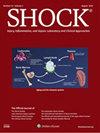caspase-1/caspase-11-hmgb1-rage/tlr4 信号在机械通气加重肺外脓毒症诱发的肺损伤中的作用。
摘要
背景:机械通气(MV)是危重病人呼吸支持的一项重要临床措施。虽然中等潮气量机械通气不会造成肺损伤,但在败血症等病理状态下,机械通气会进一步加重肺损伤。这种病理过程被称为 "两击 "理论,即最初的肺损伤(如感染、创伤或败血症)引发炎症反应,激活免疫细胞,使肺组织处于脆弱状态,更容易受到后续损伤。值得注意的是,这种机械通气对健康肺组织无害,但会通过未知机制进一步加重原有的肺损伤。最初的损伤和随后的机械通气之间的相互作用形成了一个恶性循环,大大加重了肺损伤,严重影响了患者的预后。双击理论对于理解呼吸机相关肺损伤的复杂机制至关重要,并有助于后续靶向治疗策略的开发:采用CLP小鼠模型模拟临床脓毒症患者。12 小时后,对小鼠进行 2-6 小时的机械通气。中压本身不会导致 HMGB1 释放,但会显著增强脓毒症小鼠血浆和肺组织细胞质中的 HMGB1。LysM HMGB1-/-(骨髓细胞中的 Hmgb1 基因缺失)和 iHMGB1-/- 小鼠(诱导型 HMGB1-/- 小鼠品系,在他莫昔芬治疗后 Hmgb1 基因被全面缺失)血浆和肺组织中细胞因子和趋化因子的活化、MAPK 信号通路、中性粒细胞募集和 ALI 逐渐减少。与 C57BL/6 小鼠相比,虽然 EC-HMGB1-/-(内皮细胞中的 Hmgb1 基因缺失)小鼠的炎症水平并不低,但中性粒细胞招募和肺损伤却有所减轻。与LysM HMGB1-/-小鼠相比,EC-HMGB1-/-小鼠的炎症水平较高,但中性粒细胞募集和肺损伤却显著降低。总体而言,iHMGB1-/-小鼠的上述指标水平最低。RAGE-/-小鼠的炎症水平、中性粒细胞募集和肺损伤程度都有所下降,甚至在TLR4/RAGE-/-小鼠中上述指标都进一步下降。Caspase-11-/-和Caspase-1/11-/-小鼠的炎症和中性粒细胞募集水平均有所下降,但这两种基因敲除小鼠之间无统计学差异:这些数据首次表明,Caspase-1/Caspase-11-HMGB1-TLR4/RAGE 信号通路在中毒性脓毒症诱导的肺损伤小鼠模型中起着关键作用。在 "两击 "模型中,不同种类的 HMGB1 基因敲除小鼠具有不同的肺保护机制,而位置是功能的关键。具体来说,LysM HMGB1-/- 小鼠由于骨髓细胞中 HMGB1 的缺失而产生了肺保护机制,这种机制与炎症反应的下调有关。EC HMGB1-/- 小鼠由于内皮细胞缺乏 HMGB1,产生了独立于炎症反应的独特肺保护机制,与肺泡-毛细血管通透性的改善更为相关。Abstract: Background: Mechanical ventilation (MV) is a clinically important measure for respiratory support in critically ill patients. Although moderate tidal volume MV does not cause lung injury, it can further exacerbate lung injury in a pathological state such as sepsis. This pathological process is known as the "two-hit" theory, whereby an initial lung injury (e.g., infection, trauma, or sepsis) triggers an inflammatory response that activates immune cells, presenting the lung tissue in a fragile state and rendering it more susceptible to subsequent injury. The second hit occurs when MV is applied to lung tissue in a fragile state, and it is noteworthy that this MV is harmless to healthy lung tissue, further aggravating preexisting lung injury through unknown mechanisms. This interaction between initial injury and subsequent MV develops a malignant cycle significantly exacerbating lung injury and severely hampering patient prognosis. The two-hit theory is critical to understanding the complicated mechanisms of ventilator-associated lung injury and facilitates the subsequent development of targeted therapeutic strategies. Methods and Results: The cecum ligation and perforation mice model was used to mimic clinical sepsis patients. After 12 h, the mice were mechanically ventilated for 2 to 6 h. MV by itself did not lead to HMGB1 release, but significantly strengthened HMGB1 in plasma and cytoplasm of lung tissue in septic mice. Plasma and lung tissue activation of cytokines and chemokines, mitogen-activated protein kinase signaling pathway, neutrophil recruitment, and acute lung injury were progressively decreased in LysM HMGB1 -/- (Hmgb1 deletion in myeloid cells) and iHMGB1 -/- mice (inducible HMGB1 -/- mouse strain where the Hmgb1 gene was globally deleted after tamoxifen treatment). Compared with C57BL/6 mice, although EC-HMGB1 -/- (Hmgb1 deletion in endothelial cells) mice did not have lower levels of inflammation, neutrophil recruitment and lung injury were reduced. Compared with LysM HMGB1 -/- mice, EC-HMGB1 -/- mice had higher levels of inflammation but significantly lower neutrophil recruitment and lung injury. Overall, iHMGB1 -/- mice had the lowest levels of all the above indicators. The level of inflammation, neutrophil recruitment, and the degree of lung injury were decreased in RAGE -/- mice, and even the above indices were further decreased in TLR4/RAGE -/- mice. Levels of inflammation and neutrophil recruitment were decreased in caspase-11 -/- and caspase-1/11 -/- mice, but there was no statistical difference between these two gene knockout mice. Conclusions: These data show for the first time that the caspase-1/caspase-11-HMGB1-TLR4/RAGE signaling pathway plays a key role in mice model of sepsis-induced lung injury exacerbated by MV. Different species of HMGB1 knockout mice have different lung-protective mechanisms in the two-hit model, and location is the key to function. Specifically, LysM HMGB1 -/- mice due to the deletion of HMGB1 in myeloid cells resulted in a pulmonary-protective mechanism that was associated with a downregulation of the inflammatory response. EC-HMGB1 -/- mice are deficient in HMGB1 owing to endothelial cells, resulting in a distinct pulmonary-protective mechanism independent of the inflammatory response and more relevant to the improvement of alveolar-capillary permeability. iHMGB1 -/- mice, which are systemically HMGB1-deficient, share both of these lung-protective mechanisms.

 求助内容:
求助内容: 应助结果提醒方式:
应助结果提醒方式:


